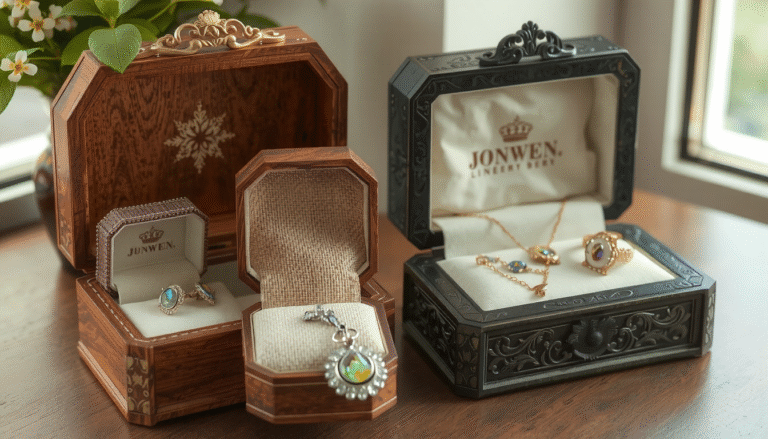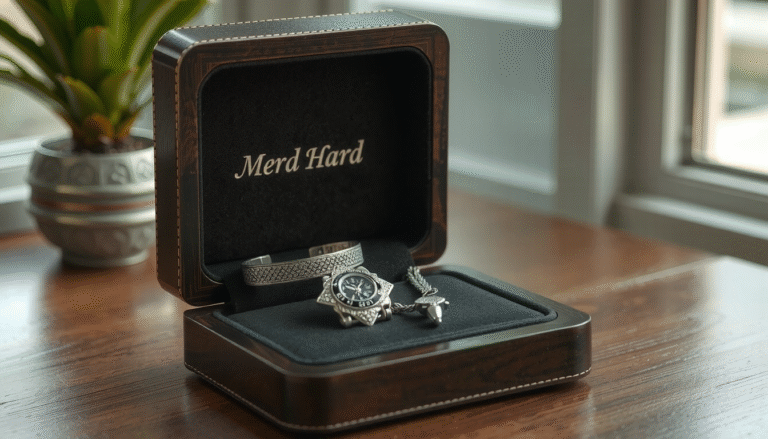A vintage Chinese black lacquer jewelry box has a deep, shiny surface. It holds more than just treasures. It holds centuries of history, art, and cultural stories. These pieces aren’t just storage boxes. They connect us to an ancient craft. Their timeless beauty adds sophistication to any room.
This guide will be your expert companion. It will help you navigate the rich heritage of these artifacts. We’ll explore everything from the origins of lacquerware to identifying, valuing, and caring for your own precious box.
A Journey Through Time: The Rich History of Chinese Lacquerware
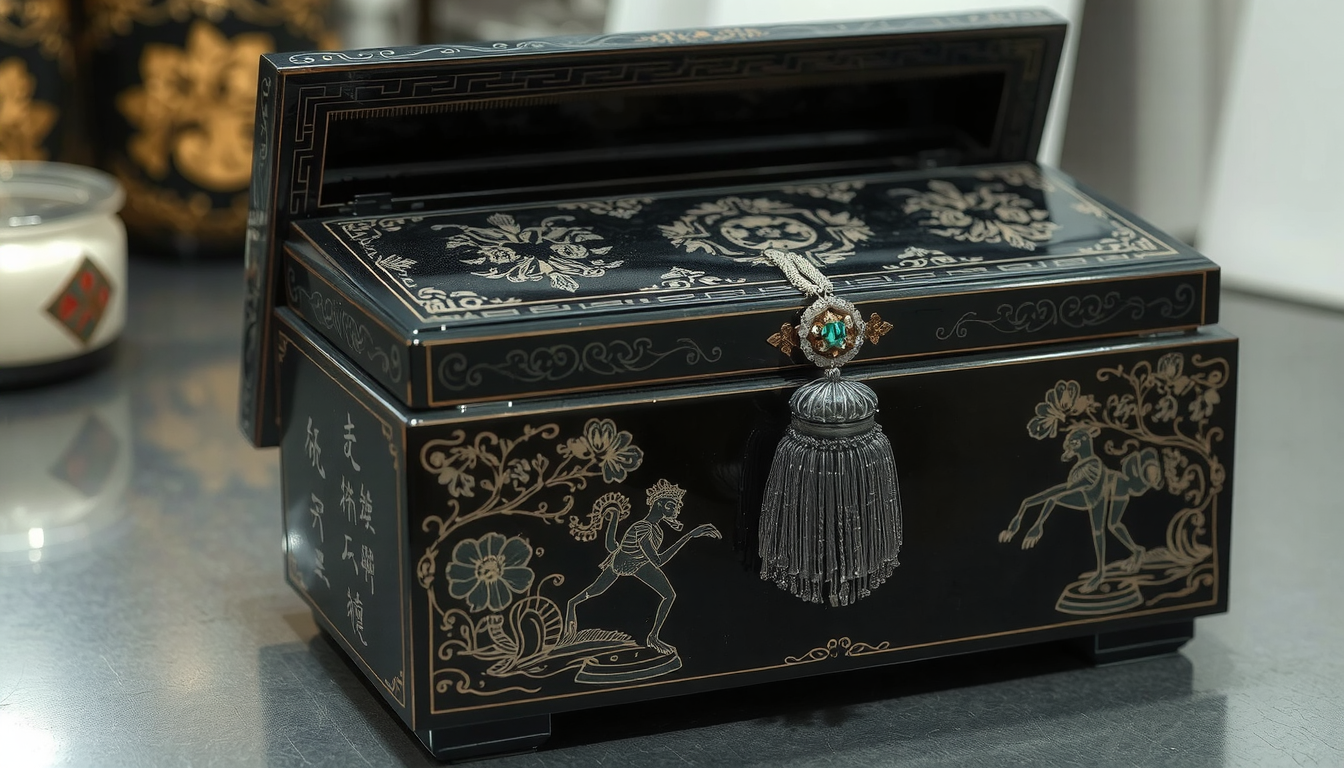 To truly appreciate a vintage Chinese black lacquer jewelry box, you must understand the deep history of the material itself. This craft has been perfected over thousands of years. It was used for practical items and imperial treasures. Your box’s story began long before it was ever built.
To truly appreciate a vintage Chinese black lacquer jewelry box, you must understand the deep history of the material itself. This craft has been perfected over thousands of years. It was used for practical items and imperial treasures. Your box’s story began long before it was ever built.
What is Lacquer?
True Asian lacquer is a remarkable natural material. It comes from the sap of the lacquer tree (Toxicodendron vernicifluum). This tree is related to poison ivy. The sap is carefully harvested, filtered, and heat-treated. This organic resin creates a finish that lasts exceptionally long. It’s waterproof and resists heat and insects.
A Legacy of Craftsmanship
The art of lacquerware is one of China’s oldest traditions. It has endured for millennia. Archaeologists have found lacquerware in Chinese tombs from the Neolithic period. The craft reached incredible heights during the Han Dynasty (206 BC – 220 AD). Items from this time show complex painting and inlay techniques. These set the standard for centuries to come.
Identifying a Genuine Vintage Chinese Black Lacquer Jewelry Box
Telling an authentic vintage piece from a modern copy requires a sharp eye and knowing touch. As experts, we look for subtle clues. We examine the materials, finish, and construction. These tell the story of an item’s age and origin. A genuine vintage Chinese black lacquer jewelry box has character that cannot be easily copied.
Examine the Core Materials and Construction
The foundation of the box reveals its age. Most vintage pieces use a lightweight wood core. This is often pine or camphor wood. Camphor wood is prized for its aromatic properties.
The interior lining is another key sign. Look for materials like silk, brocade, or simple felt. These typically come in lucky colors like red or gold. These linings should show signs of age. You might see fading, minor fraying, or a gentle patina. This is unlike the perfect look of modern polyester.
Finally, inspect the joints. Older, handcrafted boxes may have less-than-perfect joints. This shows their manual construction. Modern, machine-made pieces have seamless precision.
Feel the Finish: The Telltale Signs of True Lacquer
A genuine lacquer finish is unmistakable. It results from dozens of thin layers applied and polished by hand. This creates a deep, liquid-like gloss with real warmth.
Authentic aging shows itself in specific ways. Look for “crazing.” This is a fine, web-like network of cracks in the surface layer. It develops over decades as the material responds to environmental changes. Small chips along edges can also be revealing. They often show the distinct layers of lacquer and undercoating.

Assessing the Hardware and Inlays
The metal fittings provide crucial clues. Vintage hardware includes clasps, hinges, and handles. These are typically made of brass. They should have a natural, un-lacquered patina that develops with age and air exposure. This isn’t a uniform, artificially-aged coating.
Inlay work is a hallmark of these decorative boxes. Common materials include shimmering mother-of-pearl, carved soapstone, and occasionally semi-precious stones like jade. In vintage pieces, these inlays are hand-cut and hand-set. This means you may find slight imperfections or variations. These speak to their handmade origin.
Vintage Box Identification Checklist:
- Base Material: Is the wood core lightweight (e.g., pine, camphor)?
- Finish: Does it have a deep, lustrous shine with signs of age like fine crazing?
- Inlays: Are the mother-of-pearl or stone inlays hand-carved with slight irregularities?
- Hardware: Is the brass naturally patinated and un-lacquered?
- Lining: Does the interior silk or felt show gentle, authentic wear?
- Construction: Are the joints indicative of hand-craftsmanship rather than machine perfection?
Distinguishing Chinese from Japanese Styles
Both cultures are masters of lacquerware, but their styles differ. Japanese lacquerware often emphasizes asymmetry in its designs. It features distinct motifs like Mount Fuji or cherry blossoms. It famously uses techniques like maki-e, where gold or silver powder is sprinkled onto wet lacquer to create intricate patterns. Chinese designs frequently feature rich, balanced scenes and symbolic stories.
A Canvas of Symbols: Decoding the Artistry on Your Box
The decoration on a vintage Chinese black lacquer jewelry box is never accidental. Each painted scene and inlaid figure is part of a rich visual language. It’s filled with centuries of cultural meaning and good wishes. Understanding these symbols transforms the box from a beautiful object into readable art.
Common Motifs and Their Meanings
The artists who decorated these boxes used a well-known vocabulary of symbols. They conveyed blessings for happiness, long life, and good fortune. A scene of ladies in a garden is more than just a pretty picture. It’s an idealized vision of beauty, grace, and refined living. A piece like this Chinese Black Lacquer Octagonal Jewelry Box With Mother of Pearl Inlays often showcases such detailed scenes. It invites the owner into a story.
| Motif | Symbolic Meaning |
|---|---|
| Dragon & Phoenix | The ultimate symbols of imperial power, good fortune, and marital bliss. |
| Cranes & Peonies | Cranes represent longevity and wisdom; peonies signify wealth, honor, and love. |
| Court Ladies/Palace Scenes | A glimpse into an idealized life of beauty, culture, and elegance. |
| Landscapes (Shan Shui) | Represents harmony between humanity and nature, reflecting Taoist ideals. |
| Children at Play | A powerful blessing for fertility, a large family, and future generations. |
How to Care For and Preserve Your Lacquer Treasure
Proper care is essential to maintaining the beauty and structure of your vintage Chinese lacquer jewelry box. From our experience, a gentle and consistent approach is always best. These pieces have survived for decades. With the right maintenance, they can last for many more.
The Do’s and Don’ts of Cleaning
- Do: Use a very soft, dry, lint-free cloth, like microfiber, for regular dusting. This is often all that is needed.
- Do: For more significant dirt, slightly dampen a soft cloth with distilled water. Wipe a small area gently and dry it immediately with another soft, dry cloth.
- Don’t: Never use chemical cleaners, furniture polish, waxes, or rough materials. These can permanently cloud, scratch, or dissolve the delicate lacquer surface.
- Don’t: Avoid using too much water. It can seep into cracks or the wood core and cause swelling or damage to the lining.
Ideal Storage and Display Conditions
Where you keep your box is as important as how you clean it. Lacquer is a stable but sensitive material. It reacts to its environment over time.
To prevent fading, cracking, and peeling, keep your box out of direct sunlight. The UV rays can dull the vibrant colors and damage the finish.
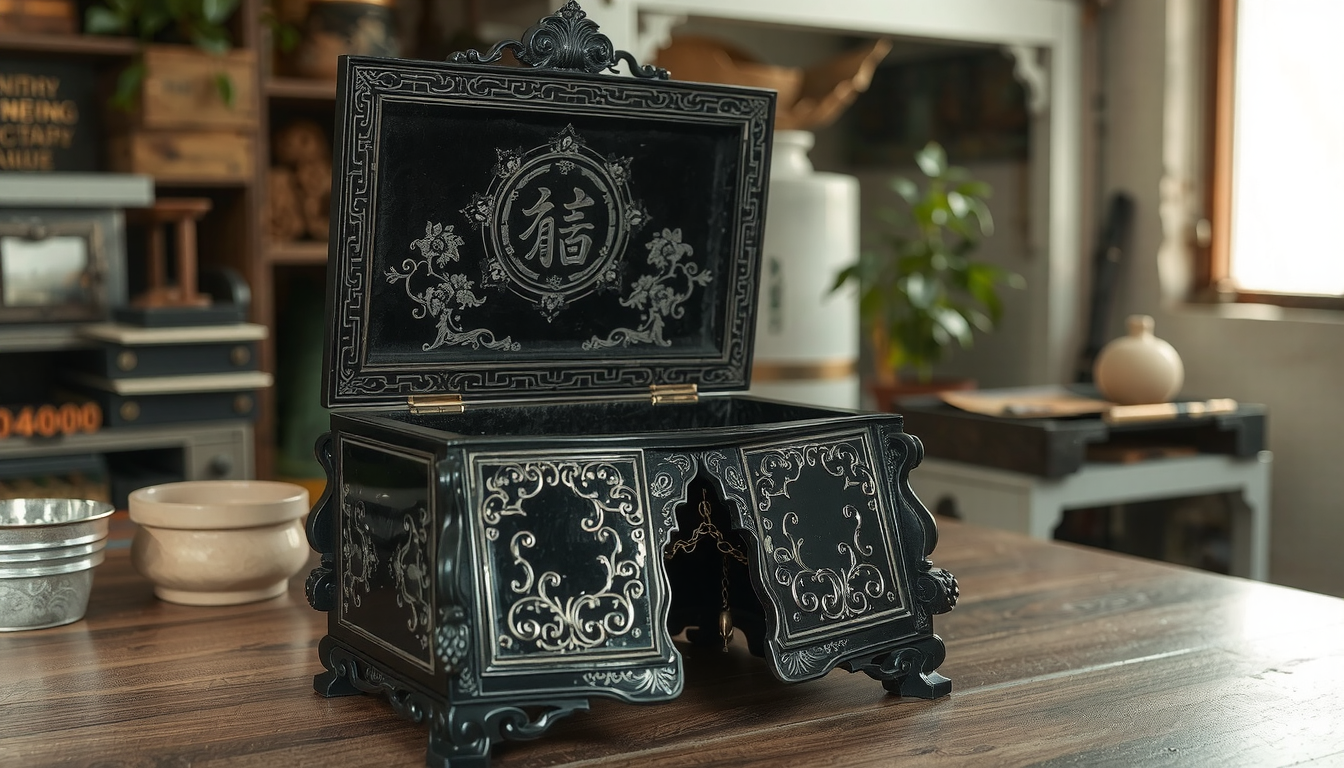
Also, avoid placing it near heat sources like radiators. Don’t put it in areas with extreme changes in temperature and humidity. This includes damp basements or drafty attics. A stable, moderate room is the ideal home for your lacquer treasure.
Finding and Valuing a Vintage Chinese Lacquer Jewelry Box
Finding the perfect vintage Chinese black lacquer jewelry box can be a rewarding hunt. These pieces appear in various places. Each offers a different discovery experience.
Where to Look
Traditional brick-and-mortar antique shops and estate sales are excellent places to find these boxes. They let you inspect the piece firsthand. Reputable online marketplaces and auction sites also offer a wide selection. Browsing a search aggregator can help you see a vast range of vintage Asian lacquerware. This helps you understand the different styles, conditions, and price points available on the market.
What Determines the Value?
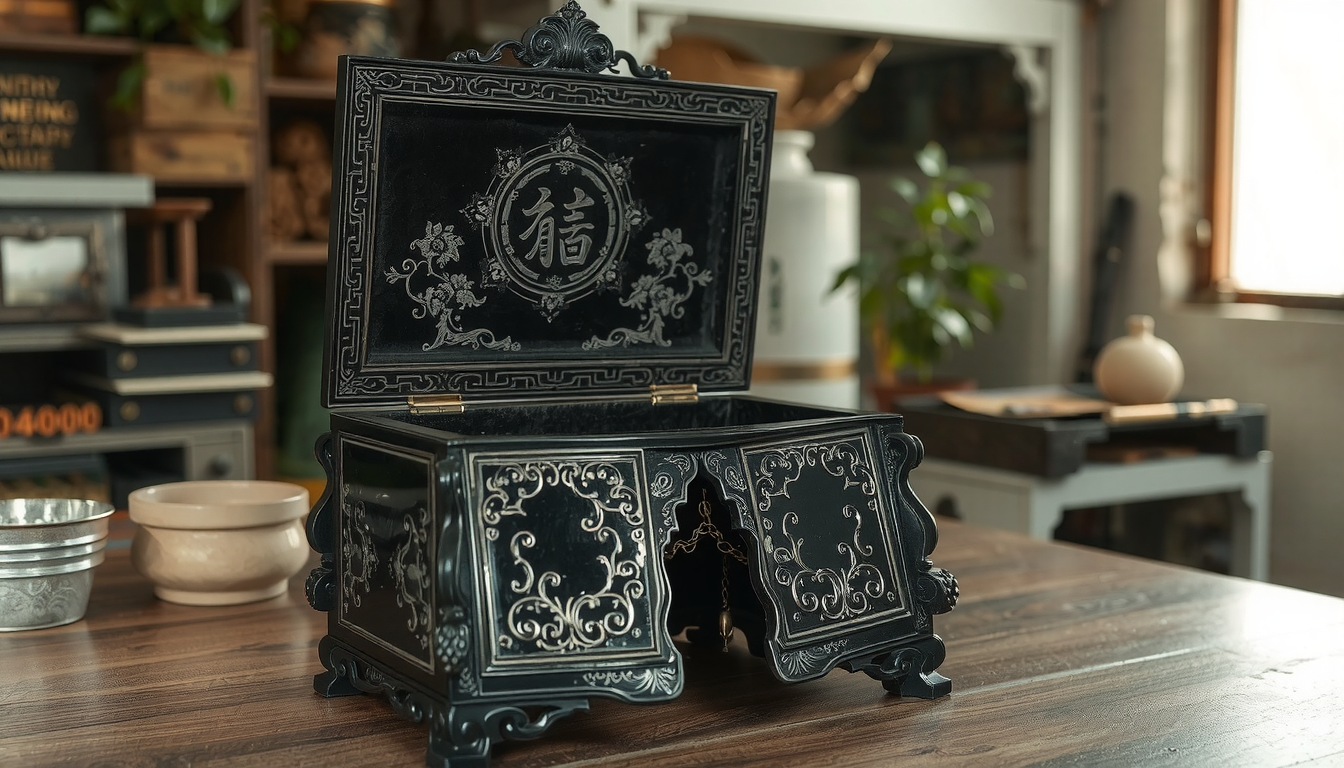 Several key factors contribute to the value of a vintage lacquer box:
Several key factors contribute to the value of a vintage lacquer box:
- Age: True antiques (100+ years) are rarer and generally more valuable than mid-20th-century vintage pieces.
- Condition: A box with minimal chips, intact inlays, and minor crazing is more desirable than one with significant damage.
- Artistry: The quality, detail, and skill of the painting or inlay work are most important. A finely executed, complex scene is valued more highly than a simple design.
- Materials: Inlays of real jade or intricately carved mother-of-pearl add more value than painted soapstone or simpler decorations.
Considering Modern and Custom Options
Some people love the look but prefer a new, perfect item. Others need specific storage configurations. Modern artisans continue this beautiful tradition. If you’re looking for high-quality, contemporary jewelry storage solutions inspired by classic designs, you might consider visiting a specialized supplier like Jewelry Box Supplier Ltd.
Frequently Asked Questions (FAQ)
How can I tell how old my Chinese lacquer box is?
Exact dating is difficult without an expert, but you can look for clues. Signs of age include natural wear on corners and edges. Look for fine crazing (hairline cracks) in the lacquer. Check the style of the hardware and artwork. Pieces from the mid-20th century are common. True antiques (100+ years old) are rarer and show a more significant, mellowed patina.
What is the difference between mother-of-pearl and soapstone inlay?
Mother-of-pearl is the shimmering inner layer of certain mollusk shells. It shimmers and changes color in the light. Soapstone is a soft, opaque rock that is easily carved. On jewelry boxes, it is often carved into figures of people or birds. Then it’s hand-painted with fine details.
Is it safe to store all my jewelry in a vintage box?
Generally, yes. The soft silk or felt-lined interiors are specifically designed to protect jewelry from scratches. However, for very delicate items like soft pearls or easily tarnished silver, make sure the lining is clean and fully intact. Avoid direct contact with any unlined wood sections.
My box has a musty smell. How can I fix it?
A musty odor usually means trapped moisture. The best remedy is to air the box out. Open it completely and place it in a dry, well-ventilated area. Keep it out of direct sunlight for several days. Placing a small, open container of baking soda or activated charcoal inside can also help absorb stubborn odors.
Are music box components in these boxes common?
Yes, many vintage Chinese jewelry boxes made for the Western export market from the 1950s to the 1970s included a small, wind-up music box. These often feature a spinning ballerina or figure. They are a charming characteristic of that era. While they add a nostalgic touch, the presence of a music box doesn’t necessarily make the piece more valuable than one with exceptional artistry or materials. For modern custom options, including musical elements, working with a specialized manufacturer like Jewelry Box Supplier Ltd can help you create a piece to your exact specifications.



